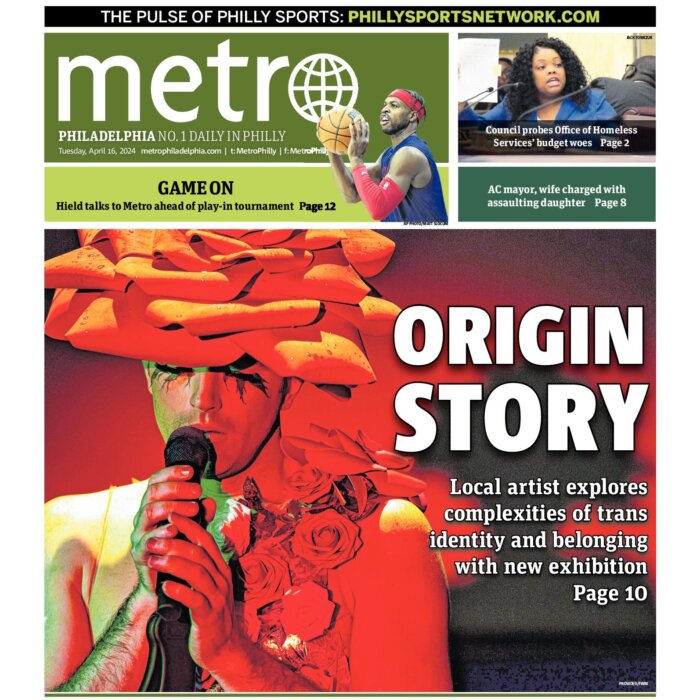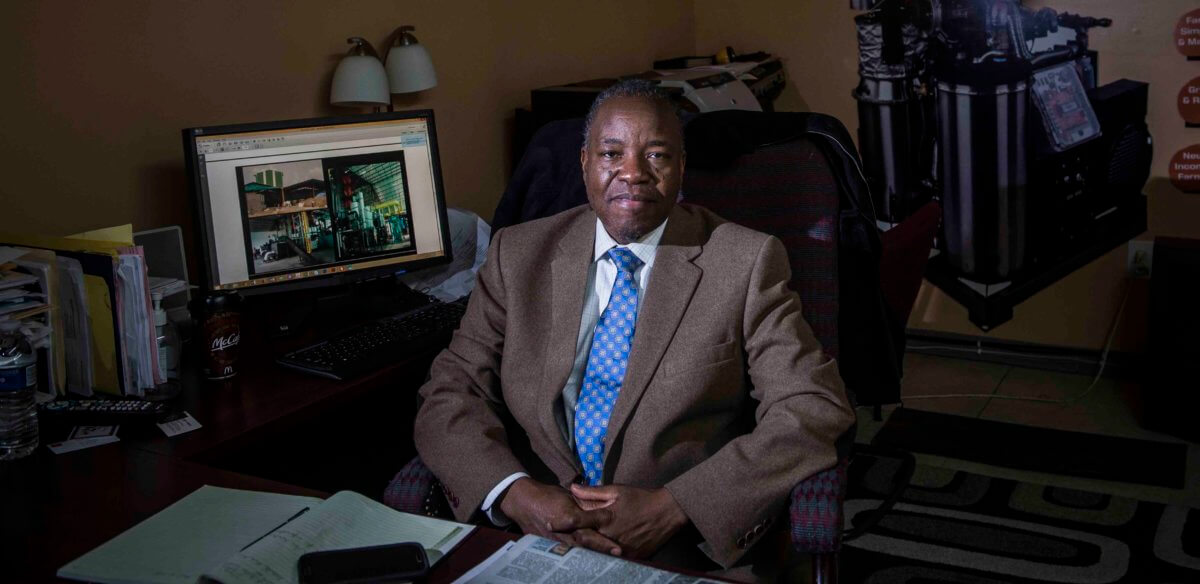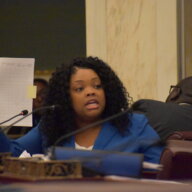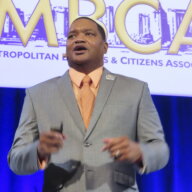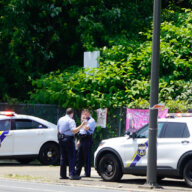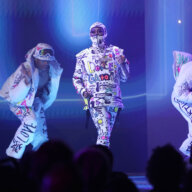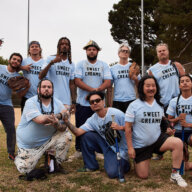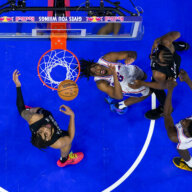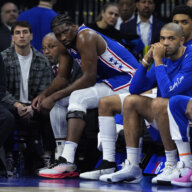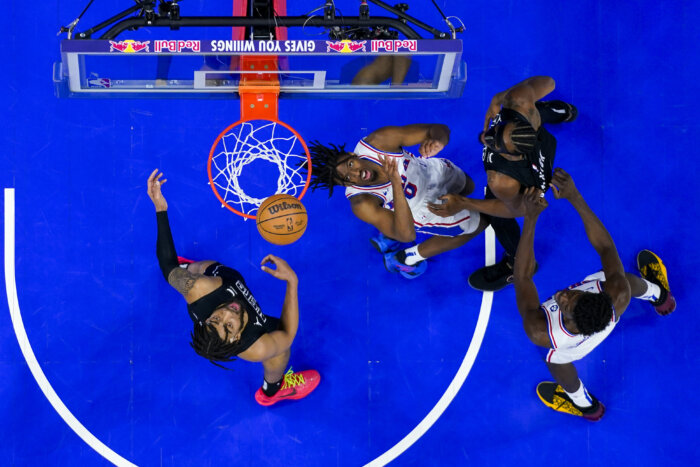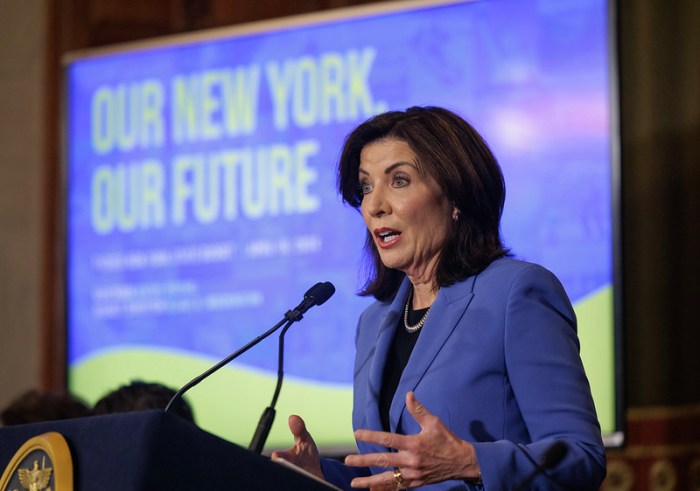Vickson Korlewala went out of his West Philadelphia home near 55th and Market streets on April 2, 2014, planning to drive to pay off some utility bills. But after just driving a few blocks, he saw a police cruiser flash its lights behind him, and pulled over. When police officers came up to his window, he was expecting to hear about a traffic violation. But instead, they told him that he was being placed under arrest for a recent robbery of an elderly woman.
When Korlewala protested, one of the officers pulled out their cell phone and showed him a grainy surveillance camera picture showing the face of another black man – not Korlewala.
“I thought it was a joke,” recounted Korlewala, a Liberian immigrant and the CEO of his own renewable energy business, Ecopower Liberia. “He said, ‘Here’s you.’ I said, ‘No, it’s not me. Look at the picture. Now look at me. That’s not me!’”
Left, a male suspect caught on surveillance video forcing a 92-year-old woman to withdraw her savings from a Citizens Bank. Right, Vickson Korlewala, who was arrested and charged with robbery, along with his wife, after the victim identified them in a photo array. The victim was unable to later re-identify the Korlewalas. (PPD/Courtesy of Ecopower Liberia)
Police had obtained a warrant for his arrest, partly based upon a 92-year-old robbery victim identifying him as the man who forced her to empty her bank account in a photo array. Police also arrested his wife, who that same victim identified as the female accomplice. A day later, the Korlewalas were charged with a second, similar robbery of an elderly woman by a male-and-female duo that had occurred months earlier at a Center City branch of Citizens Bank. Surveillance video of that robbery was never released to the public.
To this day, Korlewala can’t understand how no one in the criminal justice system stopped to closely compare the surveillance picture with his face. (Detectives acknowledged they never ran the images through the police department’s facial recognition software.)
“That guy and I look so totally different,” he said. “When my 4-year-old niece saw the picture, she cried. She said ‘That’s not Uncle Vickson.’ A 4-year-old girl can tell the difference.”
While Korlewala and the suspect on surveillance cameras were both black men with African features, no one polled by this reporter thought they were the same person. Objective measurements like distance between nose and lips, distance between eyes, breadth of nose, and breadth of lips prove that Korlewala does not really resemble the suspect. But surveillance camera images are so low quality, they are often not treated as objective evidence.
“Errors in matching identity of two facial images are common place. People make errors in 20-30 percent of comparisons even under ideal conditions with good quality images,” said Prof. Tim Valentine of Goldsmiths, University of London, citing factors like the lighting, shade, and angle of view. “Clear differences can be used to eliminate a suspect, but an absolute identification can never be made. For this reason, prosecutions should rely on other evidence than a disputed identification from CCTV.”
The Korlewalas, neither of whom had ever been arrested before, were jailed for three weeks on $1,000,000 bail, a period both describe as a traumatic experience. With support from family, neighbors and members of the Liberian community, they posted bail and fought the case for six months before it was thrown out at the preliminary hearing, due to the victims being unable to re-identify the Korlewalas.
“These were respected, hard-working people minding their own business, doing all the right things,” said Rev. Dr. Pastor Moses S. Dennis, who attended the Korlelwalas’ hearings in support. “We knew them well. We were very sure they did not do what they were accused of doing, so we were willing to go the extra mile to make sure that was proven.”
But when the Korlewalas sued the city and police who had wrongly arrested them in federal court, their suit was thrown out in summary judgment for failure to show that the officers had done anything outside the standards of their job. In November 2017, the US Court of Appeals for the Third Circuit upheld the dismissal. Faced with a long-shot petition to the Supreme Court, the Korlewalas accepted their defeat, and the court order to pay attorney’s fees for the detectives they had sued.
“I’m very disappointed with the way the civil case went. I don’t think they deserve what they went through in the first place,” said Pastor Dennis. “It’s double victimization. They went through the pain of that, just to find out there’s no consequences for the actions of law enforcement.”
2.
The fact that Vickson and Lorpu Korlewala were ever developed as suspects in the robbery of an elderly woman forced to withdraw her savings from Citizens Bank began with a bizarre twist of fate.
Philadelphia police officers Phillip Williams and Edward Bond were looking for the vehicle of the man and woman who had abducted a 92-year-old woman walking near 55th and Market streets, tricked her into withdrawing approximately $8,000 from her account and then taken the money. She was spotted being forced out of a vehicle near 57th and Chestnut on March 31, 2014.
The “flash” description from a witness was for a green Saturn SUV with a New Mexico license plate. On April 1, the officers spotted the Korlewalas black Saturn SUV parked near 55th and Market, near their home. Their car had a Pennsylvania license plate, not a New Mexico one. But it did have something else that caught the officers’ eyes – a bumper sticker reading ‘South of the Border,’ from the faux-Mexican tourist attraction in South Carolina.
“The South of the Border sticker led me to believe that someone – because people, when you say South of the Border, people think Mexico – so maybe the person thought they seen a Mexico license plate,” Officer Bond testified during a deposition for the Korlewalas’ lawsuit against the police department. “That South of the Border sticker led me to believe that this vehicle could possibly have been the vehicle involved.”
All the detectives and officers involved in the Korlewalas’ arrest agreed that it was plausible the witness may have been confused by the bumper sticker into identifying the wrong state’s license plate. But one person who disagreed was the witness himself, Vencent Acey, 49, a Verizon employee who was in his work truck outside a Verizon facility when the suspects pulled up right alongside him. He saw the victim being shoved out of a car near 57th and Chestnut and watched her fight to try to get back in. The woman got caught in the door and partly dragged as it sped away. Acey got out of his truck and rushed to help the victim, who was distraught and kept saying ‘They took my money,” he recalled. He saw a police officer across the street near a Rite-Aid pharmacy and brought her over to report the crime, later giving a description of the vehicle to detectives. He only heard about the outcome of the case when he was contacted by this reporter.
“I wasn’t mistaken,” Acey said of his the original vehicle description he gave detectives in 2014. “I know the difference between a Pennsylvania license plate, because I have one myself, and a New Mexico license plate. It’s a big difference. I know the difference between New Mexico and South of the Border.”

The suspects’ vehicle was reported as having a New Mexico license plate. The Korlewalas’ car had a PA plate and South of the Border bumper sticker. Police thought the bumper sticker may have confused the witness, who four years later still maintains he definitely saw a New Mexico plate. (NM.gov/PA.gov/Provided)
Officers’ confidence in investigating the Korlewalas based on the South of the Border bumper sticker was certainly reasonably bolstered after the victim, 92, picked Vickson’s and Lorpu’s driver’s license photos out of photo arrays of eight pictures prepared by police. The array was administered ‘double-blind,’ by detectives not directly handling the case, which is a policing “best practice” in line with the Philadelpha Police Department guidelines for identifications. Detectives on the case said they couldn’t remember who prepared the photo-array in depositions for the Korlewalas’ lawsuit.
But even still, the photo array identification method can be “suggestive,” said veteran Philly defense lawyer Paul Hetznecker, and shouldn’t overpower other evidence like bank surveillance video that showed a different person. (Hetznecker was not involved in the Korlewala case, but reviewed their court papers).
“If you were to do a statistical analysis of all the identification cases which involved a pretrial, post-incident identification procedure, I would have no doubt that there would be a significant number of misidentifications, not necessarily because of the ill will of the officers or the detectives, but because of the process,” Hetznecker said. “The person is still under the stress of the incident that just happened. They’ve been brought to this process and they believe inherently in the authority of the police, in the expertise of the police, they must have it right, so it must be the guy in the photo array.”

Vickson Korlewala was identified once by a 92-year-old victim in the above photo array – but she was unable to re-identify him in a live line-up. (Courtesy of the Korlewalas)
Police had other evidence against the Korlewalas: a trenchcoat like one the suspect wore was found in Vickson’s home, while he was observed to be somewhat short and walk with a limp, like the suspect. Lorpu was determined to have “bad teeth,” like the female suspect, but unlike the suspect, she is not a tall woman. The Korelwalas also both have thick Liberian accents, which no victim ever described.
The origin of the ‘South of the Border’ bumper sticker on their car, which wound up linking Vickson Korlewala and his wife to the criminal case for which they were jailed for nearly a month and fought in court for five more months, was itself a mystery. “It was on the car when we bought it,” Vickson Korlewala said.
3.
After police obtained photos of Vickson and Lorpu Korlewala, based on their vehicle resembling the suspects’ car, and got positive identifications of both of them in photo arrays from the 92-year-old victim, the couple was placed under arrest. Vickson was arrested after a traffic stop while detectives entered Lorpu’s hair-braiding salon and placed her under arrest.
One day after the couple was arrested, they were both brought out of holding and told they were being charged with another crime: a second, similar robbery in the 6th district of an elderly woman by a black couple who intimidated the 80-year-old victim into withdrawing money from her bank account at a Citizens Bank at 20th and Market streets. At this stage in the process, the Korlewalas were not given any chance to present evidence or defend themselves. The cases were joined in court, and at $250,000 bail per robbery per person, the couple wound up detained on $1,000,000 bail.
Notably, the 92-year-old victim did identify the Korelwalas in photo arrays, but failed to re-identify them in a live line-up. The 80-year-old victim never was able to identify them. But none of that appears to have deterred Philly prosecutors from proceeding with the case.
Meanwhile, the Korlewalas’ family, friends and fellow Liberian community members had seen images of the suspected robber broadcast on news media, and knew it wasn’t Vickson. They began organizing and reaching out to elected officials for details, and the Korlewalas’ daughter printed up T-shirts with Vickson’s face next to that of the suspect, under the message “Mistaken Identity: Release the Korlewalas.” Members of the Liberian community began pooling funds to help them fight their case.
“People were pulling money out of their retirement accounts to pay for the bail,” said Dr. Susanna J. Dodgson, a friend of the Korlewalas who became involved in efforts to spread the word about the case. “It was just appalling. He’s well-known in the African community. It was almost like, ‘Who would be the worst person to pick out of this community?’ And it would be Vickson.”
Korlewala came to the U.S. in 1983 to study environmental chemistry. As his native land was engulfed in a tragic civil war, he ended up staying in the U.S., working at a variety of companies before starting his own, Ecopower Liberia, to help bring renewable energy to his homeland, where some 90 percent of the population doesn’t have access to electricity.
“Folks are using kerosene candles and diesel and all of that. You’re inhaling fumes that are very risky,” Korlewala described. “People might just look at this as giving electricity and light to the people – but it involves all of these things down the line, how many tons of CO2 we are saving. We’re working on making folks understand our overall goals and the possible impact.”

Vickson Korlewala discusses renewable energy technology with an audience during a visit to his native Liberia. (Courtesy of Ecopower Liberia)
In 2011, he began looking into starting his own business. The U.S. Agency for International Development awarded his company a grant. He started marketing biomass-powered generators, which burned locally available materials like coconut shells, back home in Liberia. But being arrested in 2014 put all of that on hold. Korlewala had to surrender his passport and missed a planned trip to Africa while the charges were pending.
The Korlewalas posted 10 percent of their bail and were released from jail after three weeks. Four years later, both say they still feel traumatized from their time incarcerated.
“It was just being there. The shame of being in jail. The psychological effect just hit us,” Korlewala said. “That cultural shame of, you’re supposed to be in the US doing good things, and you end up locked up.”
At their first scheduled preliminary hearing in July 2014 before Judge David Shuter, the courtroom was filled with ‘Mistaken Identity’ T-shirt-wearing Liberian supporters. At the time, Liberia was being roiled by an Ebola epidemic the Korlewalas were actively fundraising to fight, and Philly’s Liberian community had just days earlier been devastated by the deaths of four Liberian children in a rowhouse fire on Gesner Street.
But they still turned up in court to watch the Korlewalas’ top-shelf defense attorneys, Kevin Mincey and Thomas Fitzpatrick, argue passionately for the case to be tossed based on a lack of evidence beyond one victim’s photo-array identification.
“They know their case is thin,” Mincey argued at the hearing against prosecutors’ requests for a new line-up identification process. “They’re trying to get a line-up to fortify an identification they don’t have.”
At that time, the 92-year-old victim from the March 31 robbery in Southwest Philly had identified the Korlewalas in a photo array, leading to their arrest. But she had failed to identify them in a subsequent live line-up. Two bank staff had also been questioned, with one saying Vickson “looks like” the suspect, another saying he “possibly” was the suspect.
The 80-year-old victim who had been robbed on February 1 in a similar robbery – accosted by a black man and woman who forced her to withdraw money from a Citizens Bank branch, this time at 20th and Market streets – had been given the Korlewalas’ pictures in a separate photo array, but didn’t identify them. (Surveillance video from Citizens Bank was viewed by police but never released to the public or the Korlewalas’ attorneys).
Mincey said having a defendant who didn’t match the suspect on the video was unusual, but not an infrequent situation.
“I’ve had cases where a guy is stopped 10 minutes after a robbery, they said the suspect was clean shaven, and my guy has a full Philly beard, and they’re still charged,” Mincey said. “That happens. It’s unfortunate, because the collateral consequences of being held, even for a short period of time, can be monumental for an individual or family like the Korlewalas.”
At their next preliminary hearing in September 2014, Judge Charles Hayden tossed the charges after finding prosecutors had still not obtained the court-ordered line-ups identifying the suspects for the case, which Judge Shuter had marked “must be tried.” Even after Judge Hayden announced his decision and the hearing adjounred, the Philly prosecutor handling the case, Joseph McCool, maintained it wasn’t over, and loudly warning the Korlewalas “Get ready for the re-arrest!” as they started to walk away after the hearing adjourned.
“That was really scary, when he said that,” Vickson Korlewala recalled. “Every police suit I saw after that, I panicked.”
A few months later, the Korlewalas applied for expungement, which the Philadelphia D.A.’s office, then led by Seth Williams, did not oppose. The charges against them were erased.

The Korlewalas, Vickson, third from left, and Lorpu, second from right, celebrate with friends and community members after charges were dropped in September 2014. (Sam Newhouse)
4.
Still reeling from the experience of being arrested and jailed, having their cell phones full of personal data and business contacts seized and never returned, along with the $600 Vickson was carrying at the time of his arrest, the Korlewalas decided to seek justice by filing a lawsuit in federal court.
“They took our phones, they took my money, but most of all, we just wanted an apology,” Vickson Korlewala said.
They hired attorney Lopez Thompson, who filed their civil rights lawsuit in November 2015, alleging false arrest and conspiracy. He said the case involves conduct that goes beyond police officers’ usual qualified immunity.
“That law is situated so that, unless you can show that a police officer has some sort of personal vendetta or they’re doing something outside of what a reasonable police officer would do, it’s hard to point the finger at them,” Thompson said. “I think this particular case falls outside that, because of the video. The video clearly shows that there was another individual that was inside that bank. There was just too many flags. … You have a video of one person, you have another person in front of you. How can you point the finger at that person?”
But in December 2015, U.S. Magistrate Judge Lynne Sitarski threw out the entire suit against five detectives on summary judgment. “The court concludes that the evidence as described here certainly gives rise to a ‘fair probability’ that the Korlewalas committed the crimes alleged, and therefore, that probable cause to arrest existed,” Sitarski wrote, writing that the photo array identification by the 92-year-old victim outweighed other evidence, including the bank surveillance video.
Thompson argued that decision would result in “manifest injustice” and appealed to the U.S. Court of Appeals for the Third Circuit. In November 2017, the Circuit Court affirmed Sitarski’s ruling. The case was never taken to the Supreme Court and is now effectively over.
Taken as a whole, some say the Korlewalas’ case is an instance of the system working, since the charges were eventually dropped.
“I look at this and see the police system of photo and witness identification worked in this case,” said former NYPD Detective Sergeant Joseph Giacalone, a professor at CUNY’s John Jay College of Criminal Justice, noting that grainy surveillance video can’t be considered reliable.
“I don’t see that as an error by the police that they should have figured out ahead of time. That’s totally subjective,” he said. “Some people would say ‘It looks like the guy to me,’ and the victim’s telling them it is, so they say ‘It’s got to be him.'”
Jim Bueermann, president of the Police Foundation, a police research group, and former chief of the Redlands, Ca. police department, said while police may have followed the rules, the end result raises questions about the “fallibility” of the criminal justice system. He wondered if police and prosecutors should have interviewed the couple, and asked for voluntary live line-ups, rather than immediately proceeding to arrest, incarceration and pressing charges.
“For somebody to stay in jail that long and then ultimately have the case against them dismissed very clearly highlights that there’s a weakness in the system,” said. “I’m not saying the police made a mistake here, because I don’t know they did. I just think it’s clear this illustrates the weakness within the system and the potential indifference the system can have to the people who became victim to a mistake.”
At this point, the Korlewalas have mostly returned to normal life. Vickson travels regularly to Liberia to market solar panel electricity generators to communities and families. But for him and his wife, their arrest remains a life-altering tragedy that permanently shook their faith in law enforcement and the US legal system.
“If this is the kind of police system and police force we have, it’s really terrible,” Vickson Korlewala said. “For these guys, just locking people up, it just says they have no value for human life at all. How can you justify that? …. I can just imagine how many folks have gone through that. There are so many, so many young folks in jail.”
The Philly police department did not answer inquiries about the case. “We are not going to accommodate your requests for comment,” a spokesperson said via email.
But the detectives who handled the two robberies, Det. Dennis Slobodian and Det. Rodney Hunt, maintained up through their depositions for the civil lawsuit that they had acted properly and arrested the right people.
“This just reinforces the lack of trust, perhaps, in the criminal justice system. There are winners and losers predetermined to some extent, there are biases,” said the Korelwalas’ pastor, Rev. Dr. Moses S. Dennis. “I’m surrounded by people who do the right thing, and they still fall victim to the system. So I tell my people, stay out of trouble, do your best, and if something happens to you like what happened to brother Vickson and sister Lorpu, we will stand up for them, and we will speak with our actions.”
This piece was written as part of a John Jay College/Harry Frank Guggenheim fellowship in criminal justice reporting.
